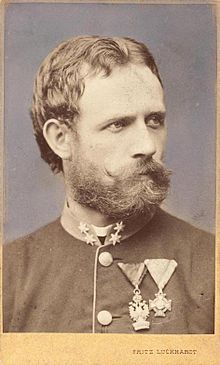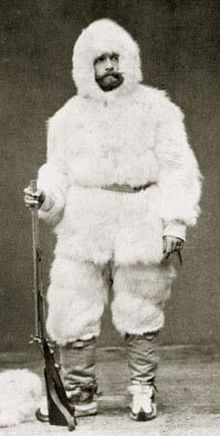Julius von Payer
Julius von Payer | |
|---|---|
 Julius Payer as First Lieutenant (around 1865) | |
| Born | 2 September 1841 |
| Died | 29 August 1915(aged 73) |
| Resting place | Vienna Central Cemetery |
| Nationality | Austrian |
| Known for | Austro-Hungarian North Pole expedition |
Julius Johannes Ludovicus Ritter von Payer(2 September 1841 – 29 August 1915), ennobledRittervon Payerin 1876, was an officer of theAustro-Hungarian Army,mountaineer,arctic explorer,cartographer,painter, and professor at theTheresian Military Academy.He is chiefly known for theAustro-Hungarian North Pole expeditionin 1872–74 and the discovery ofFranz Josef Land.
Early life and military career
[edit]Born inSchönau,Bohemia,his father Franz Anton Rudolf Payer was a retired officer of the AustrianUhlanswho died when Julius was only fourteen. His mother was Blandine, née John. Payer attended thek.k.cadet school in Łobzów nearKraków,Galicia(present-dayPoland). Between 1857 and 1859 he studied at the Theresian Military Academy inWiener Neustadt.
From 1859, Payer served as asub-lieutenantwith the Austrian 36th infantry regiment inVerona,Venetia.He participated in the disastrousBattle of Solferinoon 24 June 1859 and was honoured for his service. After promotion to the rank oflieutenantfirst class, he was posted to the garrison ofChioggia,Venetia in 1864. On 24 June 1866 he served theBattle of Custoza,seizing two guns, for which he was decorated and elevated to the rank ofsenior lieutenant.
Since 1863 Payer was assigned as a history and geography teacher to the cadet school inEisenstadt,Kingdom of Hungary (1526–1867) (present-dayAustria) and to the Theresian Military Academy. In 1868 the Austro-HungarianMinister of WarFranz Kuhn von Kuhnenfeldappointed him a general staff officer at thek.k.Military Geographic Institute inVienna,where he worked withAugust von Fligely.
Alpine exploration
[edit]In 1862 Payer had started exploratory tours of theTyroleanAlps and theHigh Tauernrange in his free time. After 1864 he explored theAdamello-PresanellaGroup and theOrtler Alps,making more than 60 first ascents. In 1864 he was, with his guide Giovanni Caturani, the first to climbAdamello(3,554 m) and missed making the first ascent of thePresanella(3,558 m) by just three weeks. All his explorations in the Ortler massif (from 1865 to 1868) were guided byde:Johann PinggerafromSulden.Together, often accompanied by a porter, they ascended almost all significant unclimbed summits, including theHoher Angelus(3,521 m),Vertainspitze(3,545 m),Palon de la Mare(3,703 m),Monte Zebru(3,735), andMonte Cevedale(3,769 m). Their new approach to theOrtler(3,905 m) became the normal route of ascent ever since.
His tours resulted in creating a detailedtopographical mapat a scale 1:56,000. Due to his achievements, Payer was transferred to the Austrian Military Geographic Institute. When in 1875, the firstAlpine club hutabove 3000 m was built on the normal route to the Ortler, it was namedde:Payerhüttein his honor.
Polar expedition
[edit]
In 1868 he was invited by the German geographerAugust Petermannto participate in the 2ndGerman North Polar Expeditionas atopographer.Travelling to the coast ofEast Greenlandon theGermaniaunder CaptainCarl Koldeweyin 1869–1870, they reached as far north asShannon Island.In 1871 he participated in the preliminaryAustro-Hungarianexpedition toNovaya Zemlya,withKarl Weyprecht.
From 1872 to 1874, Payer led theAustro-Hungarian North Pole expeditionwithKarl Weyprecht,who was Commander at sea, while Payer was Commander on shore. During this voyage they made the discovery of Franz Joseph Land, however upon their return to Vienna many critics voiced doubts about its existence and about the experiences of other participants in the expedition.[citation needed]Payer could have proven his statements using testimonies, diaries and sketches, however his efforts were thwarted, including his promotion to captain. In 1874 he resigned from the army because of political maneuvers against him and his brother officers' doubts about his discovery and his sledge journeys. He was awarded 44florinson 1 October 1874 for the discovery of Franz Joseph Land (about equal to the monthly salary of a Sub-lieutenant at the time). He was also awarded the 1975Royal Geographical SocietysPatron's Medal.[1]
However, on 24 October 1876 he was elevated to theAustrian nobilitywhich entitled him and his descendants to the style ofRitter vonin the case of male andvonin the case of female offspring.
Later life
[edit]This sectionneeds expansion.You can help byadding to it.(June 2022) |
In 1877 Ritter von Payer married the ex-wife of a banker fromFrankfurt am Main.They later had two children, Jules and Alice.
From 1877 to 1879 he studied painting withHeinrich Hasselhorstat theStädelschulein Frankfurt am Main. From 1880 to 1882 he continued his study of art at theAcademy of Fine Arts, Munich.
From 1884 to 1890 he worked as a painter inParis.
In 1890 he divorced his wife, returned to Vienna and founded a painting school for ladies.
In 1895 he planned a trip for painting toKejser Franz Joseph Fjordin northeastern (Greenland).
In 1912 he planned (at the age of seventy) an expedition in a submarine to theNorth Pole.
He died inVeldes,in historicUpper Carniola,today part of Slovenia, in 1915.
Named after Julius von Payer
[edit]
Besides the Payerhütte mentioned above and several streets in Vienna, an island of Franz Josef Land (Payer Island), thePayer MountainsinAntarcticaand Payer Land in easternGreenlandhave been named after Julius von Payer.
The southern satellite camp for the PolAres MARS2013 analog mission by theOeWF,approximately 80 km south of the base camp nearErfoud,Morocco,was namedStation Payerduring February 2013, after the main base camp had been calledCamp Weyprechtduring the landing ceremony in the morning of February 11, 2013.
See also
[edit]- The Austro-Hungarian polar expedition led by Julius von Payer was selected as main motif for the AustrianAdmiral Tegetthoff Ship and The Polar Expedition commemorative coinminted on 8 June 2005. The reverse side of the coin shows two explorers in Arctic gear (one of them resembling von Payer) with the frozen ship "Admiral Tegetthoff" behind them.
- Payer Island
Bibliography
[edit]- Julius von Payer,Die Österreich-Ungarische Nordpol Expedition in den Jahren 1869–1874(Wien 1876) (The Austro-Hungarian North Pole Expedition of 1869 to 1874 ", Vienna, 1876)
- Andreas PöschekArchived2006-06-22 at theWayback Machine:Geheimnis Nordpol. Die Österreichisch-Ungarische Nordpolexpedition 1872–1874.- Wien: 1999 (download as PDFArchived2006-07-21 at theWayback Machine)
References
[edit]- ^"List of Past Gold Medal Winners"(PDF).Royal Geographical Society. Archived fromthe original(PDF)on 27 September 2011.Retrieved24 August2015.
External links
[edit]- Works by or about Julius von Payerat theInternet Archive
- Website of the Payer Hütte located in the Ortler Alps
